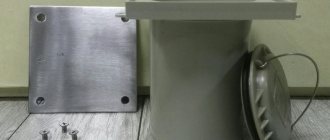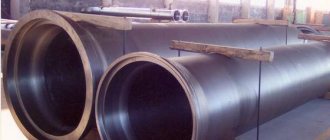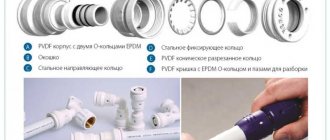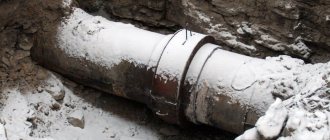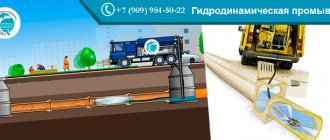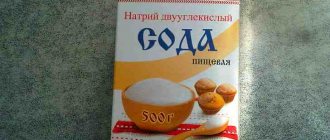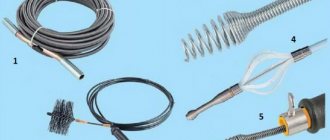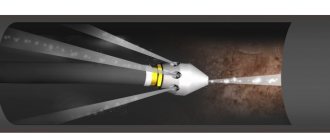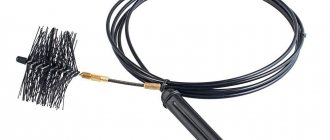Clogged sewer pipes are a problem that can arise in everyone’s apartment. You can cope with this task using a plunger and special solutions. But they cannot always help either. The most popular and affordable tool for clearing complex blockages is considered to be a flexible shaft or cable. For its manufacture, a steel, elastic, well-bending wire is used, on one end there is a handle, and on the other there is a threaded connection intended for attachments.
ATTENTION! A unique, highly effective product has been developed for cleaning sewer pipes, eliminating any blockages. The product is a concentrated mixture of enzymes that easily break down and process fat accumulations and any deposits of organic origin. One package of Saniclean will last you a whole year! Read more"
Depending on the complexity of the blockage, different types of nozzles are used. Most often they are sold as separate elements and are not included with the cable.
Types of sewer blockages
Blockages form for various reasons. This may be the negligence of the owner, who regularly pours greasy waste and large particles of household garbage into the sewer, or the inevitable natural growth of deposits during operation.
It is customary to distinguish the following types of blockages:
- Mechanical. There was construction debris and other foreign objects in the sewer.
- Operational. Particles of food waste, grease, hair or other small particles gradually accumulate on the inner surface of the pipeline walls.
- Mineral. Rust and lime deposits. Rust can form a blockage exclusively in a metal pipeline, while limescale deposits can be deposited on any materials. The rate of growth of lime deposits directly depends on the quality of the water.
It is important! Cast iron drains are considered to be the most prone to blockages. The material of such a pipeline is porous, and particles of grease and dirt easily settle on it. Plastic pipelines are less susceptible to this unpleasant phenomenon.
Methods for cleaning pipes when sewerage is clogged
The vast majority of homeowners prefer to use old, proven (although not always effective) methods to deal with sewer blockages:
- Using a plunger. The simplest method to use, which, however, can only help against small blockages.
- The use of special chemical reagents that decompose organic compounds. The method is effective, but it is undesirable to use it for plastic pipelines, which may simply not withstand aggressive chemical exposure.
- Mechanical cleaning with a special plumbing cable. In pipelines made of plastic materials, this cleaning method should also be used with caution. In addition, flexible cable will be difficult to use in pipelines with a large number of bends or turns.
- Folk recipes. Using salt, soda and vinegar in various proportions.
Note! None of the considered methods guarantees complete cleaning of the pipeline. The length of the cleared area will most likely be small.
Nowadays, the most effective cleaning technology is the use of hydrodynamic units.
We recommend that you read: Types of water valves and features of their repair
The units are produced in several variations - from professional to compact (household). The former are distinguished by their impressive size and often operate on the basis of vehicles. The scope of application of such units is large main pipelines.
The latter are small devices that can be operated by one person. Such installations are suitable for servicing private households, apartments, and offices.
Hydrodynamic cleaning technology
Hydrodynamics for sewer flushing involves careful treatment of the internal walls of the sewer with water supplied under high pressure (this figure is 100-200 atmospheres). This pressure has an effect on the pipe walls similar to treatment with a stiff brush.
At the end of the flushing, the pipe returns to the quality of a new product. In addition to this, plaque will accumulate much more slowly on a renewed smooth surface.
The design of the hydrodynamic installation is very simple. The device consists of several elements:
- Water compressor.
- Drive: for small household installations – electric. Bulky professional devices are often self-contained and powered by a gasoline or diesel engine.
- A hose through which water is supplied under pressure.
- Tip with nozzle.
Before starting the cleaning procedure, the optimal pressure level for the pipeline is set. In household networks, this figure, as a rule, should not exceed 150 atmospheres. Higher values are fraught with damage at pipeline joints.
Next, the end of the hose with the nozzle is placed into the pipe through a special inspection hatch, toilet drain, or other suitable hole. The compressor is connected to the power source, and liquid begins to flow under pressure. Powerful jets of water propel the hose along the pipe, simultaneously destroying any blockages that get in its way. The installation operator can control the passage of the installation and, if necessary, adjust the pressure level.
After eliminating the blockage (at this moment the accumulated water will begin to quickly drain), it is worth running the unit several times along the same section in order to thoroughly clean the problem area.
We recommend that you read: Installing a deflector on a chimney with your own hands
Definition and purpose of nozzles
Design options for nozzles for sewer cleaning
Nozzles for sewer cleaning are used in the hydrodynamic method of pipeline cleaning. They are connected to a powerful apparatus hose inserted into the drain hole, which, under high water pressure, is capable of removing plaque from the internal surfaces of pipes and eliminating even hard blockages and nitrous oxide.
Previously, this technique was only the final stage after cleaning with a cable, but now, thanks to powerful pumps, you can do without mechanics.
This method is optimal for plastic lines, as it minimizes the risk of damage to the pipe walls.
For work, special-purpose hydrodynamics and car wash devices are used. Attachment elements that make washing more efficient are connected to both devices.
Types of nozzles for hydrodynamic installation
The efficiency of the hydrodynamic machine in each specific case directly depends on the correct choice of nozzle. There are several types of nozzles:
- Universal. Best suited for servicing short-distance domestic sewer networks. Universal nozzles provide good maneuverability, which allows cleaning to be carried out in the shortest possible time.
- Rotary. During operation, the nozzle rotates around its axis, due to which jets of water act on blockages at constantly changing angles. Effective in the fight against fat deposits.
- Garnet-shaped. Area of application: large-diameter main pipelines. They feature a powerful cleaning jet and increased traction.
- Triangular. Designed for complex blockages that cannot always be dealt with using universal nozzles. Due to its shape, the cutting and sawing effect of the pointed edges is added to the effect of water jets.
- Bottom. Designed for cleaning drainage systems and storm sewers, where sediments mostly accumulate at the bottom of the pipeline. The shape of the nozzle resembles a thickened spatula, equipped with a wedge-shaped end with nozzles.
Note! The kit should definitely have a universal nozzle. It (albeit with less functionality) can replace any other.
The nozzles also differ in the number of jets. There can be one jet (central), or several, evenly distributed on the front of the device.
Any nozzle is equipped with direct and reverse type nozzles. The first ones throw out jets of water along the direction of movement, and are responsible for clearing blockages. Secondly, the liquid jets are directed backwards, providing the installation with the jet thrust necessary to move through the pipeline.
Attachment for drill or screwdriver
If there is little water flow in the bathroom, the sink is clogged, or there is an unpleasant smell in the kitchen that cannot be removed with a freshener, you need to act immediately. With the help of Saniclean you can easily cope with the situation without a plumber... Read more»
A convenient product for clearing blockages in sinks, bathtubs, and toilets. The end of the wire is inserted into the pipe, and when the trigger is pressed, the spiral itself begins to move forward, easily overcoming the bends of the pipe.
The turntables are designed to remove blockages in pipes with a diameter of up to 40 mm. The spiral size reaches up to 7 meters. It is easy to operate manually, as they are equipped with a convenient handle for rotation. Removable attachments for turntables are brushes and scrapers; There are straight, cone-shaped, pear-shaped. The nozzles can be used to clean ventilation and chimney systems.
Advantages and disadvantages of the method
The use of hydrodynamic installations has a number of undeniable advantages:
- The inner walls of the pipes are not damaged. The pressure of water, even such a strong one, is not capable of harming solid material.
- The cleaning procedure takes relatively little time. For a standard apartment, one hour will be enough; completely cleaning the sewer in a large private house will take 3-4 hours.
- No harmful chemical compounds are used during the work.
- After hydrodynamic flushing, the throughput of the pipeline increases to its original level. Other methods do not guarantee such a result.
- The hose of the hydrodynamic unit bends easily, which makes it possible to equally successfully use it both on straight and on turning sections.
- The device is able to function effectively at subzero temperatures, when other cleaning methods will be powerless due to ice jams. Here it will be enough to simply supply hot water to the device.
- The hydrodynamic machine not only removes blockages, but completely flushes the pipeline.
We recommend that you familiarize yourself with: Polypropylene (PPR) pipe reinforced with aluminum
Among the negative aspects are the high financial costs of carrying out the procedure (however, it is not necessary to buy a flushing system - you can rent it, or order a similar service from specialists). In addition, the device consumes large volumes of water. Thus, to clean large main pipelines, about 300 liters of water per minute will be required. Economical household models consume about 20 liters per minute.
In order to avoid having to deal with the problem of blockages for as long as possible, you should use your sewer system as carefully as possible. It is worth installing a grate at each drain hole to retain large particles of debris. To combat fat deposits, you need to regularly pour hot water down the drain with the addition of special chemicals.
The nuances of flushing home sewerage
Video pipe inspection
Installations for flushing sewer pipes at home are easy to use and come with instructions. It describes in detail the steps to use the device. However, there are nuances, knowledge of which will help a beginner to cope with the task effectively:
- The holes on the attachment elements are located so that jet thrust is formed. It gives movement to the hose, so there is no need to push it with force.
- After being inserted into the sewer system, the flexible element is carefully moved in the direction of the riser.
- The hose is inserted not only into the inspection hatch, but also into the drain hole of the toilet or sink.
- After removing the blockage, the pipes are washed with a stream of hot water. It's a good idea to add a disinfectant cleaner.
- The hose part is removed from the pipeline only after the device is turned off.
Devices for cleaning pipelines are used for preventive cleaning and in the event of an accident. If you decide to buy such equipment, be guided by the length and diameter of the line, and when selecting nozzles, take into account the material from which the pipes are made. This will allow you to save money, because more powerful units are more expensive.
It is beneficial to buy attachments as a set so that you always have the necessary element at hand. To quickly detect blockages, get video equipment for telediagnosis.
With the right approach and choice of hydraulic equipment and nozzles, blockages of any complexity can be eliminated without the involvement of professionals.
